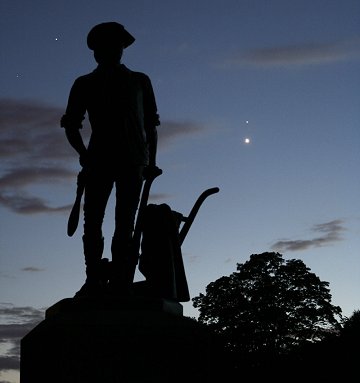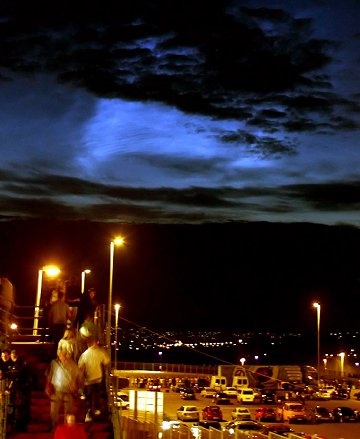 Where's Saturn? Is that a UFO--or the ISS? What's the name of that star? Get the answers from mySKY--a fun new astronomy helper from Meade. Where's Saturn? Is that a UFO--or the ISS? What's the name of that star? Get the answers from mySKY--a fun new astronomy helper from Meade. VENUS AND SATURN, SIDE-BY-SIDE: This weekend, Venus and Saturn are putting on a lovely show in the evening sky. "In commemoration of our country's upcoming Independence Day celebration, we chose to photograph the planets from historic Concord, Massachusetts," say Imelda Joson and Edwin Aguirre. (continued below) 
"In this shot, Venus and Saturn appear beside the Minute Man Monument at the foot of Old North Bridge, where the first shots of the American Revolution were fired in 1775." The show's not over: The two planets are still side-by-side tonight, barely 1o apart. Look for them after sunset as the twilight sky fades to black: sky map. more images: from Mohammad Javad Fahimi of Kerman, Iran; from Miguel De La Torre of Playas de Tijuana, Tijuana B.C. Mexico; from Sorin Hotea of Alba Iulia, Romania; from Marcelo Bissaro of Campinas, Brazil; from Wade Howlett of Bullsbrook, Western Australia; from Mariano Ribas of Buenos Aires, Argentina; from John Sachs of Hanover, Pennsylvania; from Daniel Ethier of Woodbury, Minnesota; from Keith Aaron of Frederick, Maryland; from Simon Chan of Perth, Western Australia; from Peter Naglič of near Celje, Slovenia; from Ivica Skokic of Zagreb, Croatia; from Peter Rosén of Stockholm, Sweden; from Stan Richard at the Ashton Observatory near Des Moines, Iowa; AT THE DOORSTEP OF SPACE: Noctilucent clouds (NLCs) float much higher than ordinary clouds, as shown in this June 29th photo from Viktor Veres of Mogyorod, Hungary: 
"The dark clouds in the foreground are common altostratus clouds (4 to 5 km high)," says Veres. In the background are NLCs, located 80+ km above Earth's surface. This puts them at the doorstep of space itself. This altitude difference explains why NLCs glow at night. NLCs are so far above Earth's surface, they are able to catch the rays of the sun even when it's dark near the ground. (The International Space Station glows at night for the same reason.) The blue color of NLCs comes from scattering of sunlight by very tiny ice crystals in the clouds; blue is scattered more than other colors. Noctilucent clouds have been very active in recent weeks, so be alert! Watch the sky about an hour after sunset. If you see electric-blue tendrils spreading up from the western horizon, you've probably spotted an NLC. June 2007 Noctilucent Cloud Gallery
["Noctilucent Cloud"--the song] [Night-Sky Cameras] | 
